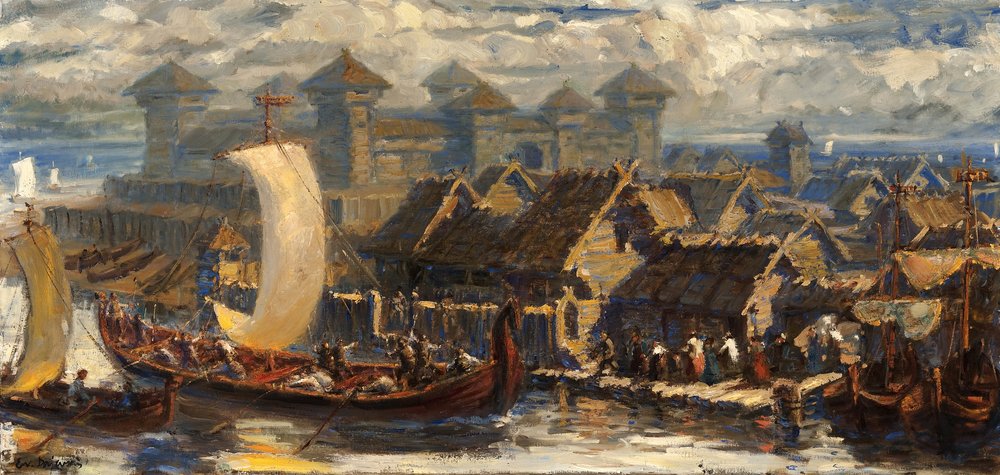Stop 03

Ancient Harbor. | Senā osta.
Oil on canvas | Eļļa uz audekla, 23.5 in x 49.5 in (59.69 x 125.73 cm), 1964.
My father was always intrigued by the ancient history of the Balts, or Baltic peoples. In particular, he was fascinated by archaeological evidence indicating maritime trade among the Balts prior to the 12th century, when Christianity arrived in Baltic lands. He studied accounts of Vikings and merchants who sailed across the Baltic Sea and made contact with the early Latvian tribes known as the Curonians, Semigallians, Livs and Sellonians. These societies were open to the outside world. Archaeological evidence in present-day Kurzeme province, the land of the Curonians, indicates that Vikings moved among them. This painting depicts an imagined fortification and a harbor visited by Vikings in the vicinity of modern-day Liepaja, where my father began his career as an artist.
In His Own Words:
Ancient Places (Stops 3 – 9)
“My first guides into the world of art were Hermanis Aplocins and Janis Sudmalis, who worked in the Stieglitz Art School traditions, as well as Nora Drapce—a student of the great Latvian master Jānis Rozentals. At the Liepaja School of Decorative Arts, thanks to Janis Sudmalis in particular, an important emerging focal point of interest for me became regional ethnic styles and composition. It was possible for me to become familiar with the distinct cultural areas of Latvia’s Lower Kurzeme region: Rucava, Barta and Nica.”
Viņa
paša vārdos:
Senvietas (3. - 9. pietura)
„Mani pirmie ievadītāji mākslas pasaulē bija Hermanis Aplociņš, Jānis Sudmalis, kas strādāja Stiglica mākslas skolas tradicijās, un Nora Drapče – Rozentāla skolniece. Skolā, sevišķi pateicoties J. Sudmalim, nozīmīgu vietu ieņēma latviešu etniskie stili un kompozīcija. Bija iespēja iepazīties ar Lejas Kurzemes etniskām vietām: Rucavu, Bārtu un Nīcu. Dekoratīvajā darbnīcā bija mani pirmie ievadījumi teātra dekorācijā. Praktizēties pie īstu dekorāciju gleznošanas varēja Liepājas teātra darbnīcā pie toreizējā dekorātora – gleznotāja Artūra Baumaņa.”